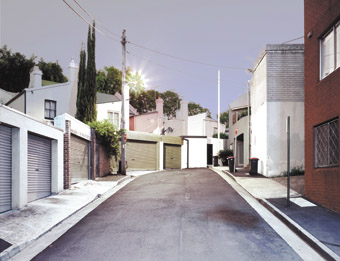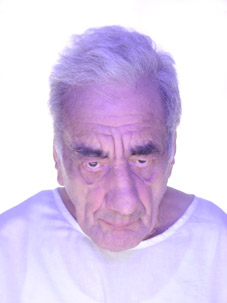aglow in the dark
keith gallasch in the underworld of german-australian photomedia

Verona (2007), Lux Loci,
Thomas Weinberger
courtesy of thirtysevendegrees – Contemporary Fine Art Gallery, Sydney
Verona (2007), Lux Loci,
Thomas Weinberger
AN AURA OF WEIRDNESS HOVERS OVER ACP EXHIBITIONS, EMANATING FROM EVOCATIONS OF SURREAL WORLDS, LATERAL DOCUMENTATION OF THE OUTER LIMITS OF SOCIAL LIFE AND THE EVERYDAY MADE STRANGE, AN ENLIGHTENING UNEASINESS COMPOUNDED BY THE GALLERY’S STRATEGY OF CREATING IMMERSIVE INSTALLATIONS OF PHOTOGRAPHIC AND VIDEO WORKS. THE NEW GERMAN PHOTOMEDIA EXHIBITION IS NO EXCEPTION.
In the plain white front room, the walls are lined with architect-cum-photographer Thomas Weinberger’s Lux Loci—unpeopled inner city Sydney suburban street scenes, seemingly shot at night, but glowing eerily with something of that odd neutrality, beyond colour terms, of the sky at the moment between the blue of day and the black of night. Some of these streets are mine and I find myself seeing them, literally, in a new light—as not quiet real, almost as if painted, cleansed of superfluity and oddly transcendent, the streetlights’ rays the epitome of the image’s glow. Apparently Weinberger achieves this defamiliarisation by merging long day and night-time exposures of the same site. The effect is unnerving, especially in the largest of the photographs, seen above, yielding a rich if indeterminate suggestiveness.

No Cure, 2006, production still
Boris Eldagsen
No Cure, 2006, production still
In the darkened main gallery, you find yourself surrounded by the four huge screens of Boris Eldagsen’s No Cure on which are projected four elderly figures in white hospital gowns, their deeply etched physiognomies tinged with a blue that might be bleeding from a medical scanner. These giants speak in turn, sadly, anxiously, even angrily, as if to you, or across the space to each other, their German recital of bleak song lyrics from The Cure subtitled in English on the opposite screen and counterpointed with Australian composer David Chisholm’s subterranean murmuring of Siegfried’s funeral march. This stillness of the subjects makes this work portraiture, their movements and utterances make it drama.

Natascha Stellmach, Good Girl #3,
courtesy ACP
Natascha Stellmach, Good Girl #3,
Nearby there’s an old white wardrobe. You open it, enter and find yourself in the ACP’s back gallery and, like Alice, somewhere even stranger. On the wall in front of you are roadkill frog skins and a small cut-out photo of a falling acrobat, the bodies all curiously alike; behind you is a doll in a kangaroo suit, the words “Nazi Girl” emblazoned on her t-shirted chest; and in the room itself a bed under which a television set glows with scattered raw images, among them the slaughter of a fowl. On a tree stump sits a copy of the artist’s book, The Book of Back (the title too of the installation) in which a family history is bizarrely (and attractively) documented with fact, fantasy, collage and family photographs. This bedroom is a haunted hearth, its book a bubbling cauldron of the unconscious. The maker, Natascha Stellmach, was born in Germany and lives and works in Australia.
The heightened detail in the imagery of Weinberger and Eldagsen and their mutual, unearthly, transforming radiance is countered by the raw physicality of Stellmach’s objects and her room’s threatening darkness; but all three collectively conjure other states of being that take us into and beyond ourselves. It’s quite an experience. New German Photomedia was part of the Goethe Institut’s innovative gerMANY FACES australia festival.
gerMANY FACES australia, New German Photomedia, Australian Centre for Photography, Aug 24-Sept 29
See also a review of Faust/Murnau on page 26.
RealTime issue #81 Oct-Nov 2007 pg. 5






